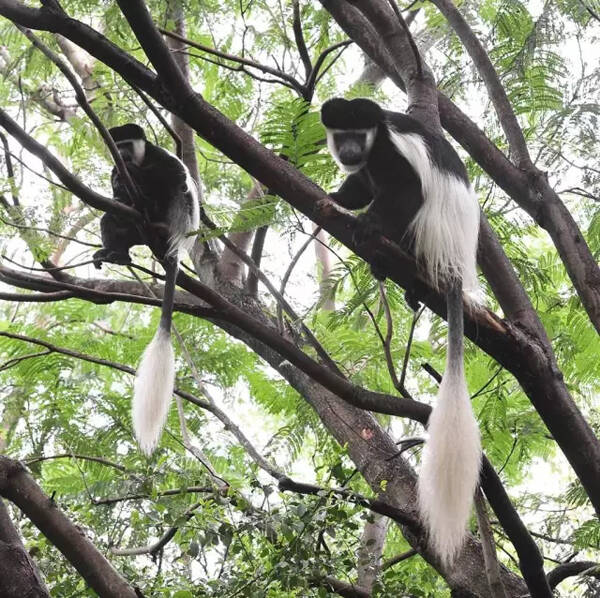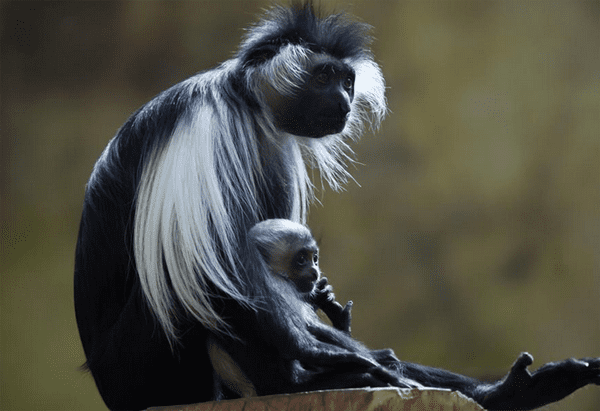Colobus angolensis
IUCN
LCBasic Information
Scientific classification
- name:Colobus angolensis
- Scientific Name:Colobus angolensis,Colobus、Angolan Black-and-white Colobus、Angolan Colobus,Angolan black and white colobus monkey
- Outline:Primates
- Family:Cercopithecidae Colobus
Vital signs
- length:49-68cm
- Weight:6.1-11.7kg
- lifetime:20-29years
Feature
It has long white eyebrows and long white hair like a cape on both sides of its body.
Distribution and Habitat
Distributed in Angola, Burundi, Congo, Democratic Republic of Congo, Kenya, Malawi, Mozambique, Rwanda, United Republic of Tanzania, Uganda and Zambia.
It inhabits a variety of habitats including subtropical and tropical dry forests, rainforests, scrublands, mountains, lowlands, alpine bamboo forests, savannas and swamps. This species inhabits primary and secondary lowland to montane forests at elevations up to 3,000 m.
Appearance
The Angora colobus is a medium-sized arboreal monkey, 49-68 cm long and weighing 6.1-11.7 kg. The beautiful and flowing tail is longer than the body, sometimes more than 1 meter, with long white eyebrows, long white hair like a cloak on both sides of the body, and four distinctive fingers on the forelimbs, with long and soft hair, the hair color is black and white. With a light body and long limbs, the body is larger and heavier than ordinary monkeys, with only four fingers. The anal wart is very small and the tail is very long, with a female tail length of 706 mm and a male tail length of 829 mm. There is often a white section at the end of the tail, and the cheek pouch is also smaller than that of ordinary monkeys. The thumb has degenerated into a small wart, so it is called a colobus monkey.
Males are slightly larger than females. The fur of the newly born Angora colobus is completely white, and it begins to change at the age of about three months.
Details
Angola Colobus (scientific name: Colobus angolensis) is also known as Colobus, Angolan Black-and-white Colobus, and Angolan Colobus. It has 6 subspecies.

Angola colobus monkeys are diurnal and arboreal species that live in the upper and middle layers of the forest and rarely come to the ground. They live in family groups of up to 25 individuals, and can also gather in large groups of more than 300 individuals. They usually live in a relatively small social group, including an adult male, several females and their children who have not yet become independent. Several females will raise the young monkeys in the family together. Males will leave home before they reach adulthood, while females will stay in the family.
Different families of Angola colobus monkeys generally do not live in harmony. They will protect and compete for habitats with each other. Each group of colobus monkeys occupies a small area and follows a fixed route from where they sleep to where they eat. When other colobus monkeys invade their area, both sides will face each other, smack their tongues and wag their tails, but will not fight. The offended colobus monkeys will jump up and down and roar at the same time, sometimes roaring continuously for up to 20 minutes. Their roars are very loud and can generally be heard 1.5 kilometers away. Male colobus monkeys climb high in the trees and then jump down from one branch of a tree to another. In this way, they demonstrate and show off to each other, and finally a group of colobus monkeys retreat, with the leading male colobus monkey as the rear guard.

Angola colobus monkeys can mate and reproduce all year round. The marriage is polygamous. There are usually 2-6 adult females in a group. Males are dominant in the family and can mate with any adult female in the group. They reproduce every two years, with the peak period being September-October. The gestation period is about 147-178 days. Each baby is born with only one child, and occasionally twins. The newborn monkeys are all white and live with their mothers. The young monkeys always hang on their mothers' chests and hold on to their mothers' fur. After 3 months, they grow to the same color as their parents. They can move freely at 7 months old. They are sexually mature at around 4-6 years old. They can generally live 20-24 years, with a maximum lifespan of 29 years.

Although the Angola Colobus may be quite abundant in the areas where they live. However, the fragile habitat is destroyed and humans hunt them for their fur and meat in the jungle, especially in densely populated areas. In some areas, such as the Kakamega Forest in Kenya, their numbers are declining quite rapidly.
Listed in the IUCN Red List of Threatened Species in 2008 ver 3.1 - Least Concern (LC).
Listed in the CITES Appendix II of the Washington Convention as a protected animal.
Protect wild animals and stop eating game.
Maintaining ecological balance is everyone's responsibility!








